Strategic Plan and Implementation Report for Wigram Borneo Restaurant
VerifiedAdded on 2021/11/19
|17
|3887
|303
Report
AI Summary
This report presents a strategic plan and implementation strategy for the Wigram Borneo Restaurant (WBR), focusing on its expansion in Christchurch. The plan emphasizes a focus differentiation strategy to attract customers, leveraging authentic Borneo cuisine and a unique ambiance. The report outlines key strategic areas, including customer satisfaction, service delivery modes, employee performance, revenue generation, and regional expansion. It details specific goals, key actions, performance indicators, and timelines. The implementation section covers staffing requirements, organizational structure, culture, values, and contingency planning. The report includes an executive summary, table of contents, and references, providing a comprehensive analysis of WBR's strategic direction and operational considerations.
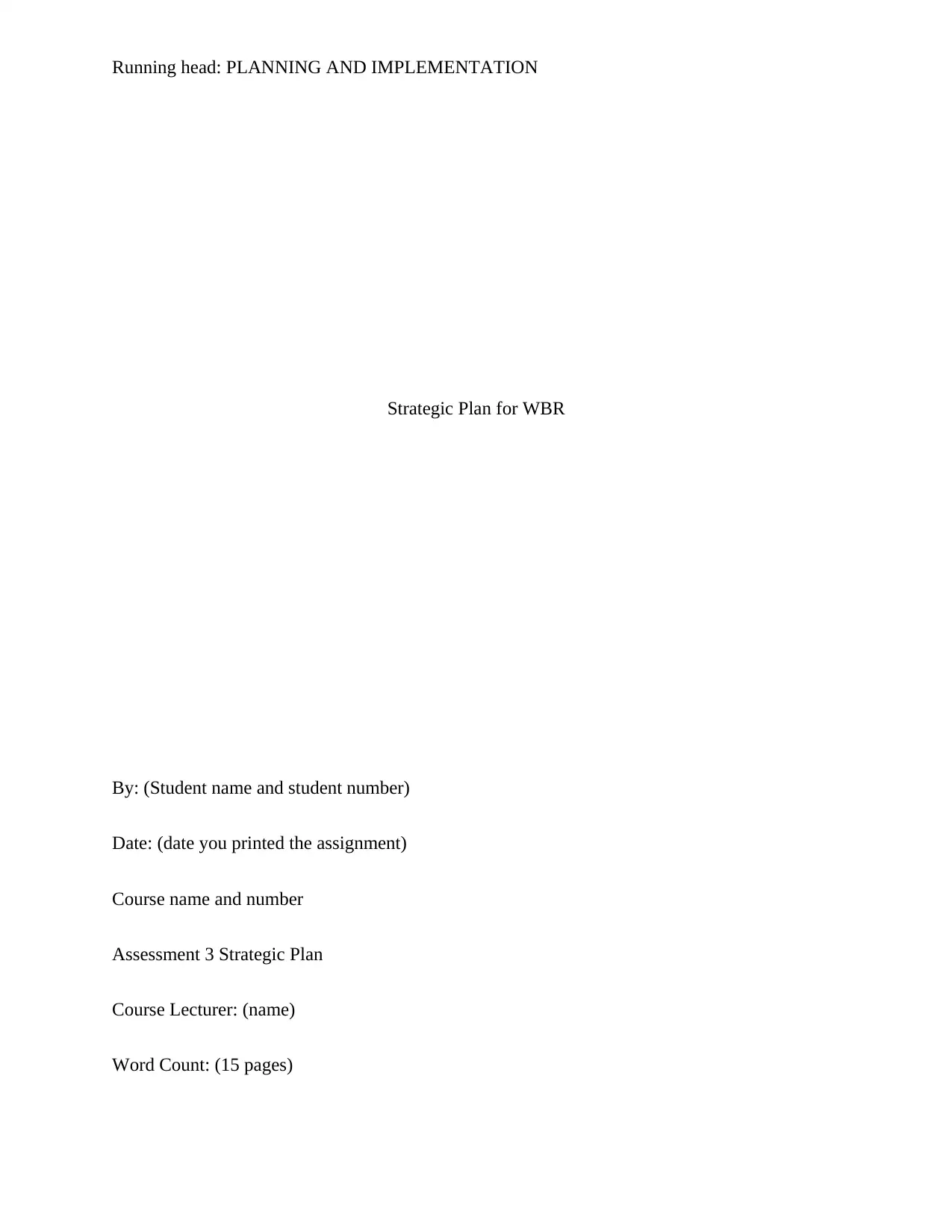
Running head: PLANNING AND IMPLEMENTATION
Strategic Plan for WBR
By: (Student name and student number)
Date: (date you printed the assignment)
Course name and number
Assessment 3 Strategic Plan
Course Lecturer: (name)
Word Count: (15 pages)
Strategic Plan for WBR
By: (Student name and student number)
Date: (date you printed the assignment)
Course name and number
Assessment 3 Strategic Plan
Course Lecturer: (name)
Word Count: (15 pages)
Paraphrase This Document
Need a fresh take? Get an instant paraphrase of this document with our AI Paraphraser
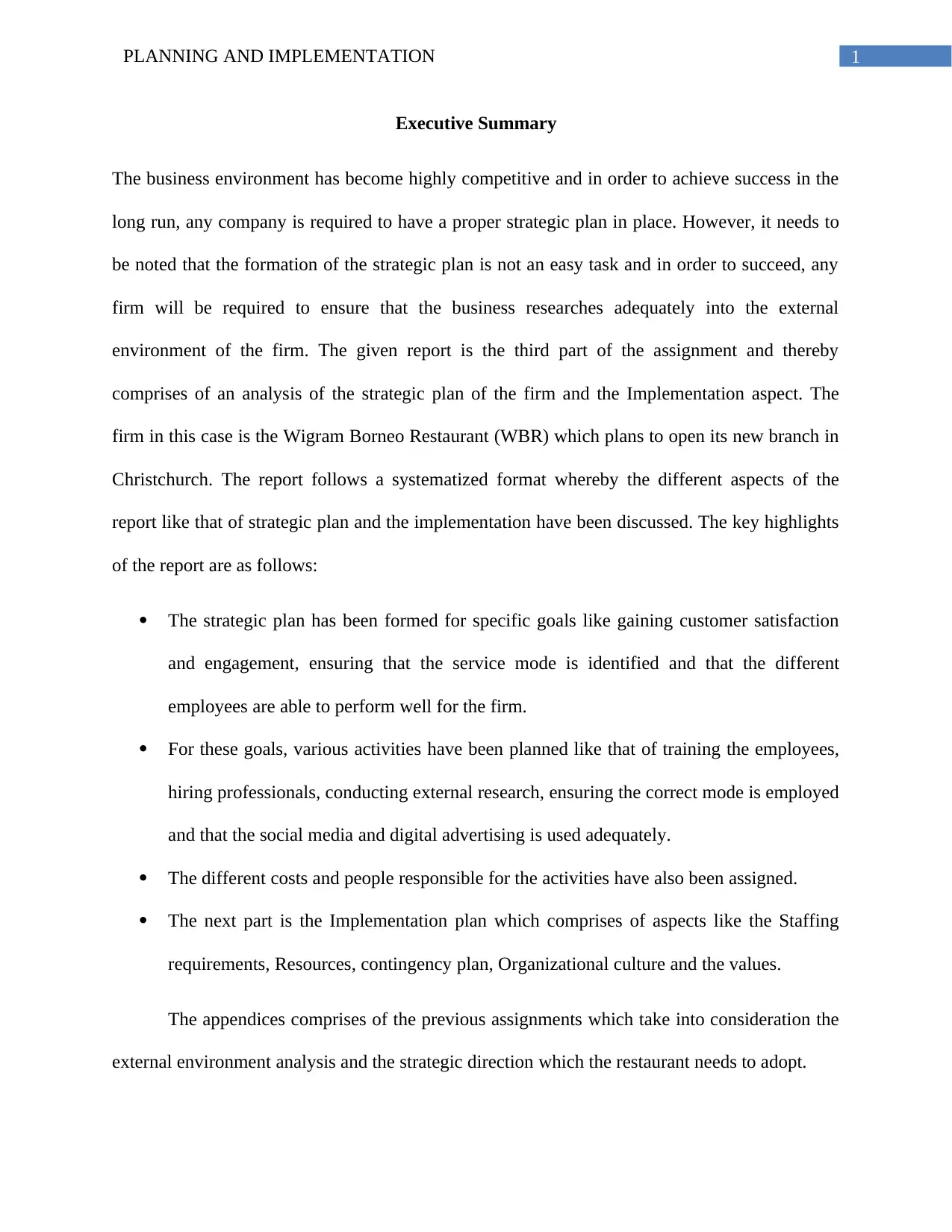
1PLANNING AND IMPLEMENTATION
Executive Summary
The business environment has become highly competitive and in order to achieve success in the
long run, any company is required to have a proper strategic plan in place. However, it needs to
be noted that the formation of the strategic plan is not an easy task and in order to succeed, any
firm will be required to ensure that the business researches adequately into the external
environment of the firm. The given report is the third part of the assignment and thereby
comprises of an analysis of the strategic plan of the firm and the Implementation aspect. The
firm in this case is the Wigram Borneo Restaurant (WBR) which plans to open its new branch in
Christchurch. The report follows a systematized format whereby the different aspects of the
report like that of strategic plan and the implementation have been discussed. The key highlights
of the report are as follows:
The strategic plan has been formed for specific goals like gaining customer satisfaction
and engagement, ensuring that the service mode is identified and that the different
employees are able to perform well for the firm.
For these goals, various activities have been planned like that of training the employees,
hiring professionals, conducting external research, ensuring the correct mode is employed
and that the social media and digital advertising is used adequately.
The different costs and people responsible for the activities have also been assigned.
The next part is the Implementation plan which comprises of aspects like the Staffing
requirements, Resources, contingency plan, Organizational culture and the values.
The appendices comprises of the previous assignments which take into consideration the
external environment analysis and the strategic direction which the restaurant needs to adopt.
Executive Summary
The business environment has become highly competitive and in order to achieve success in the
long run, any company is required to have a proper strategic plan in place. However, it needs to
be noted that the formation of the strategic plan is not an easy task and in order to succeed, any
firm will be required to ensure that the business researches adequately into the external
environment of the firm. The given report is the third part of the assignment and thereby
comprises of an analysis of the strategic plan of the firm and the Implementation aspect. The
firm in this case is the Wigram Borneo Restaurant (WBR) which plans to open its new branch in
Christchurch. The report follows a systematized format whereby the different aspects of the
report like that of strategic plan and the implementation have been discussed. The key highlights
of the report are as follows:
The strategic plan has been formed for specific goals like gaining customer satisfaction
and engagement, ensuring that the service mode is identified and that the different
employees are able to perform well for the firm.
For these goals, various activities have been planned like that of training the employees,
hiring professionals, conducting external research, ensuring the correct mode is employed
and that the social media and digital advertising is used adequately.
The different costs and people responsible for the activities have also been assigned.
The next part is the Implementation plan which comprises of aspects like the Staffing
requirements, Resources, contingency plan, Organizational culture and the values.
The appendices comprises of the previous assignments which take into consideration the
external environment analysis and the strategic direction which the restaurant needs to adopt.
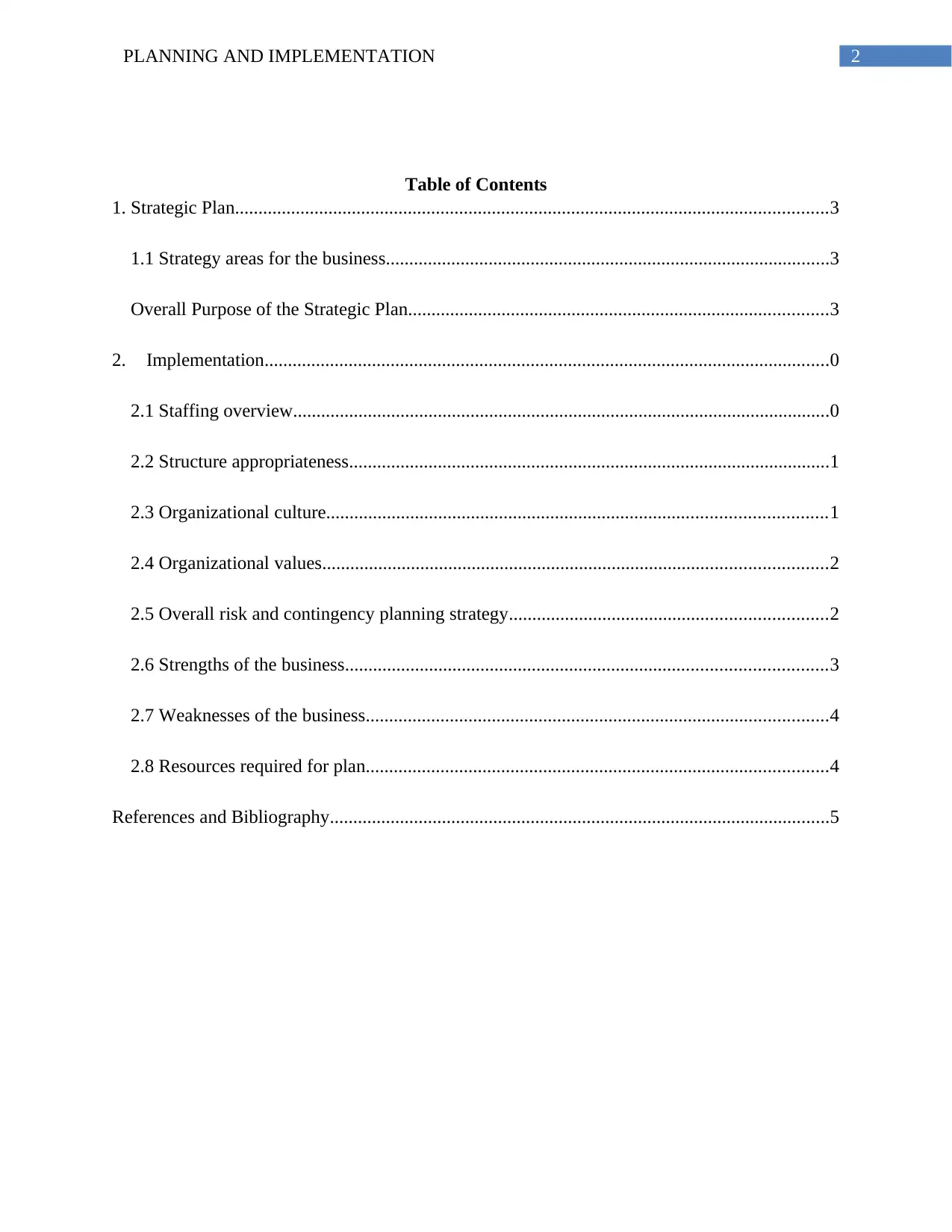
2PLANNING AND IMPLEMENTATION
Table of Contents
1. Strategic Plan...............................................................................................................................3
1.1 Strategy areas for the business...............................................................................................3
Overall Purpose of the Strategic Plan..........................................................................................3
2. Implementation.........................................................................................................................0
2.1 Staffing overview...................................................................................................................0
2.2 Structure appropriateness.......................................................................................................1
2.3 Organizational culture...........................................................................................................1
2.4 Organizational values............................................................................................................2
2.5 Overall risk and contingency planning strategy....................................................................2
2.6 Strengths of the business.......................................................................................................3
2.7 Weaknesses of the business...................................................................................................4
2.8 Resources required for plan...................................................................................................4
References and Bibliography...........................................................................................................5
Table of Contents
1. Strategic Plan...............................................................................................................................3
1.1 Strategy areas for the business...............................................................................................3
Overall Purpose of the Strategic Plan..........................................................................................3
2. Implementation.........................................................................................................................0
2.1 Staffing overview...................................................................................................................0
2.2 Structure appropriateness.......................................................................................................1
2.3 Organizational culture...........................................................................................................1
2.4 Organizational values............................................................................................................2
2.5 Overall risk and contingency planning strategy....................................................................2
2.6 Strengths of the business.......................................................................................................3
2.7 Weaknesses of the business...................................................................................................4
2.8 Resources required for plan...................................................................................................4
References and Bibliography...........................................................................................................5
⊘ This is a preview!⊘
Do you want full access?
Subscribe today to unlock all pages.

Trusted by 1+ million students worldwide
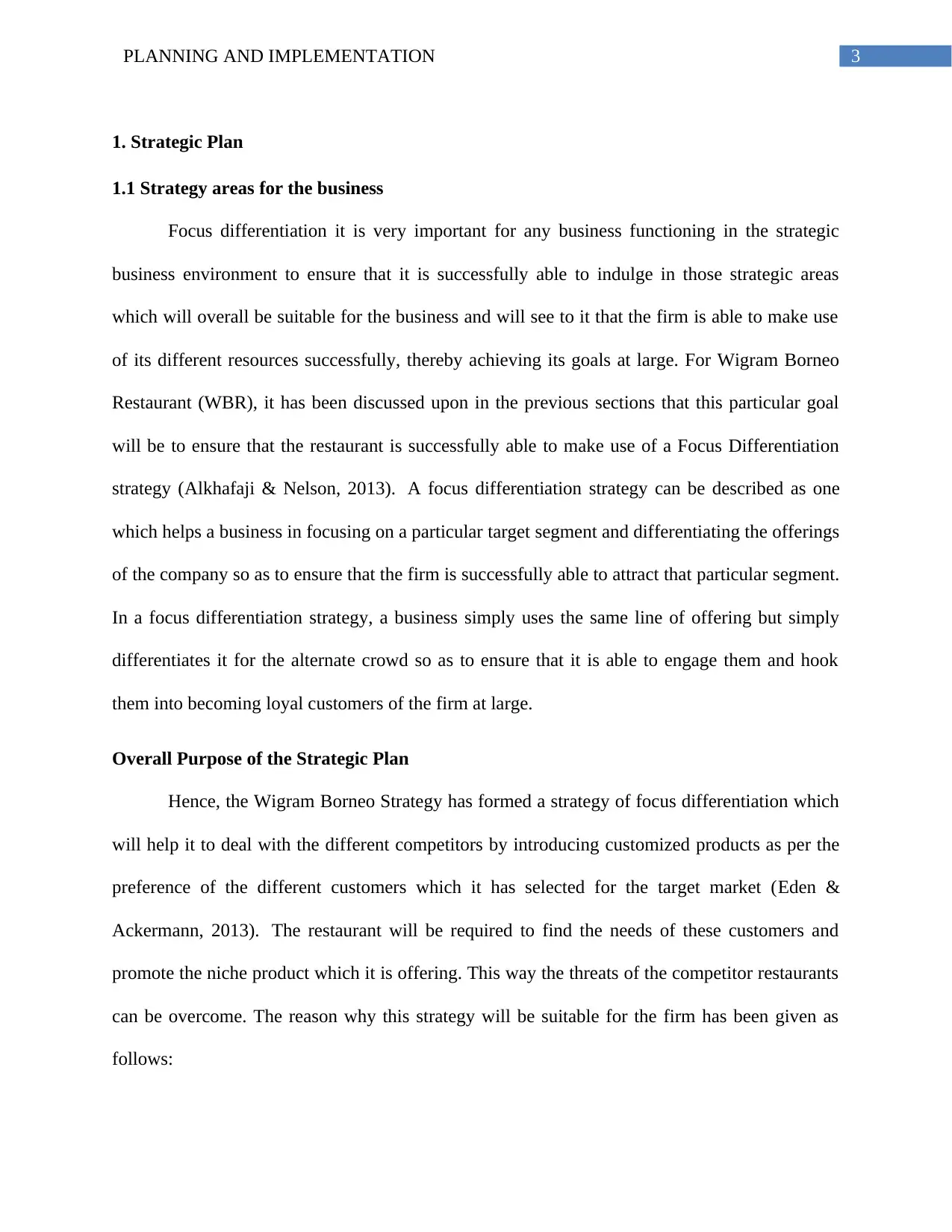
3PLANNING AND IMPLEMENTATION
1. Strategic Plan
1.1 Strategy areas for the business
Focus differentiation it is very important for any business functioning in the strategic
business environment to ensure that it is successfully able to indulge in those strategic areas
which will overall be suitable for the business and will see to it that the firm is able to make use
of its different resources successfully, thereby achieving its goals at large. For Wigram Borneo
Restaurant (WBR), it has been discussed upon in the previous sections that this particular goal
will be to ensure that the restaurant is successfully able to make use of a Focus Differentiation
strategy (Alkhafaji & Nelson, 2013). A focus differentiation strategy can be described as one
which helps a business in focusing on a particular target segment and differentiating the offerings
of the company so as to ensure that the firm is successfully able to attract that particular segment.
In a focus differentiation strategy, a business simply uses the same line of offering but simply
differentiates it for the alternate crowd so as to ensure that it is able to engage them and hook
them into becoming loyal customers of the firm at large.
Overall Purpose of the Strategic Plan
Hence, the Wigram Borneo Strategy has formed a strategy of focus differentiation which
will help it to deal with the different competitors by introducing customized products as per the
preference of the different customers which it has selected for the target market (Eden &
Ackermann, 2013). The restaurant will be required to find the needs of these customers and
promote the niche product which it is offering. This way the threats of the competitor restaurants
can be overcome. The reason why this strategy will be suitable for the firm has been given as
follows:
1. Strategic Plan
1.1 Strategy areas for the business
Focus differentiation it is very important for any business functioning in the strategic
business environment to ensure that it is successfully able to indulge in those strategic areas
which will overall be suitable for the business and will see to it that the firm is able to make use
of its different resources successfully, thereby achieving its goals at large. For Wigram Borneo
Restaurant (WBR), it has been discussed upon in the previous sections that this particular goal
will be to ensure that the restaurant is successfully able to make use of a Focus Differentiation
strategy (Alkhafaji & Nelson, 2013). A focus differentiation strategy can be described as one
which helps a business in focusing on a particular target segment and differentiating the offerings
of the company so as to ensure that the firm is successfully able to attract that particular segment.
In a focus differentiation strategy, a business simply uses the same line of offering but simply
differentiates it for the alternate crowd so as to ensure that it is able to engage them and hook
them into becoming loyal customers of the firm at large.
Overall Purpose of the Strategic Plan
Hence, the Wigram Borneo Strategy has formed a strategy of focus differentiation which
will help it to deal with the different competitors by introducing customized products as per the
preference of the different customers which it has selected for the target market (Eden &
Ackermann, 2013). The restaurant will be required to find the needs of these customers and
promote the niche product which it is offering. This way the threats of the competitor restaurants
can be overcome. The reason why this strategy will be suitable for the firm has been given as
follows:
Paraphrase This Document
Need a fresh take? Get an instant paraphrase of this document with our AI Paraphraser
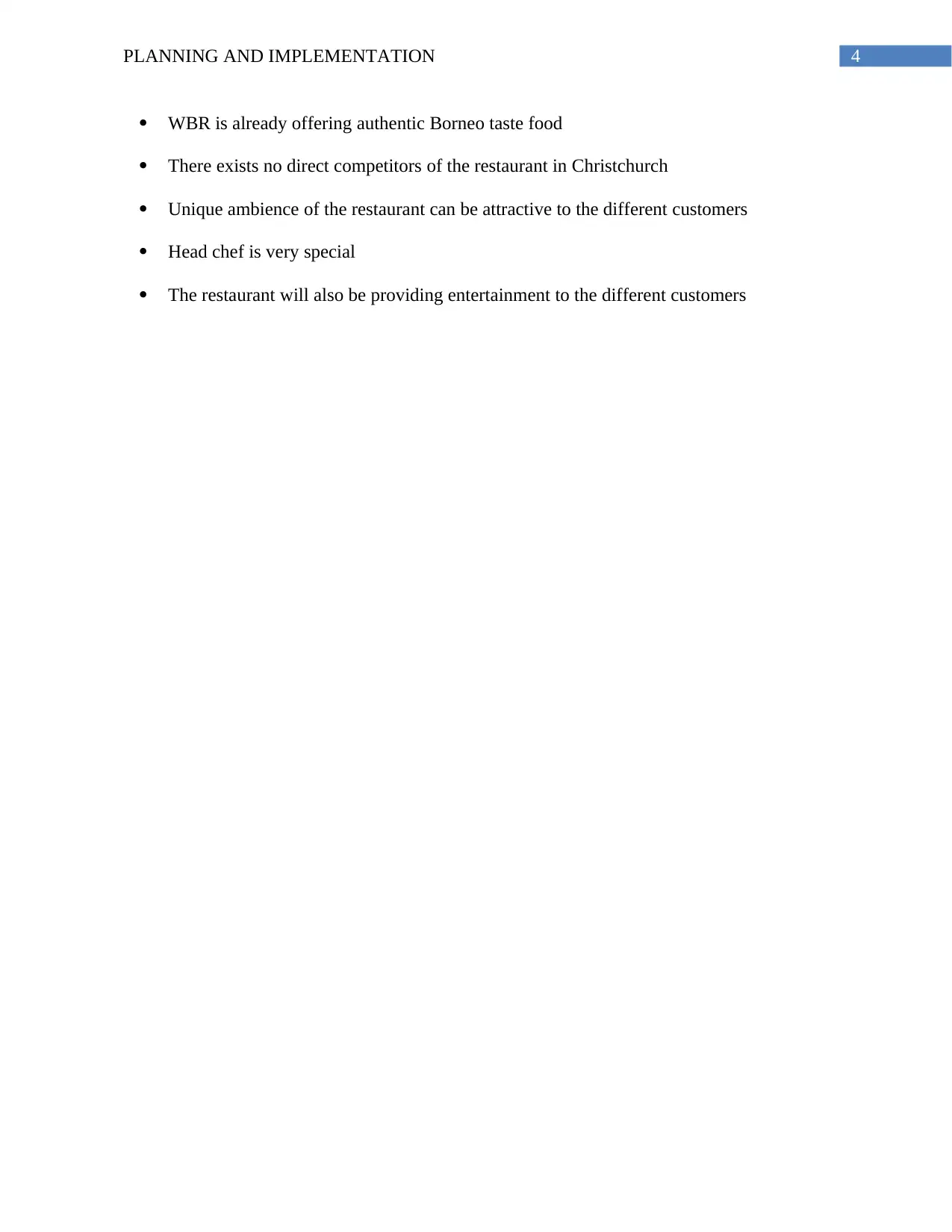
4PLANNING AND IMPLEMENTATION
WBR is already offering authentic Borneo taste food
There exists no direct competitors of the restaurant in Christchurch
Unique ambience of the restaurant can be attractive to the different customers
Head chef is very special
The restaurant will also be providing entertainment to the different customers
WBR is already offering authentic Borneo taste food
There exists no direct competitors of the restaurant in Christchurch
Unique ambience of the restaurant can be attractive to the different customers
Head chef is very special
The restaurant will also be providing entertainment to the different customers
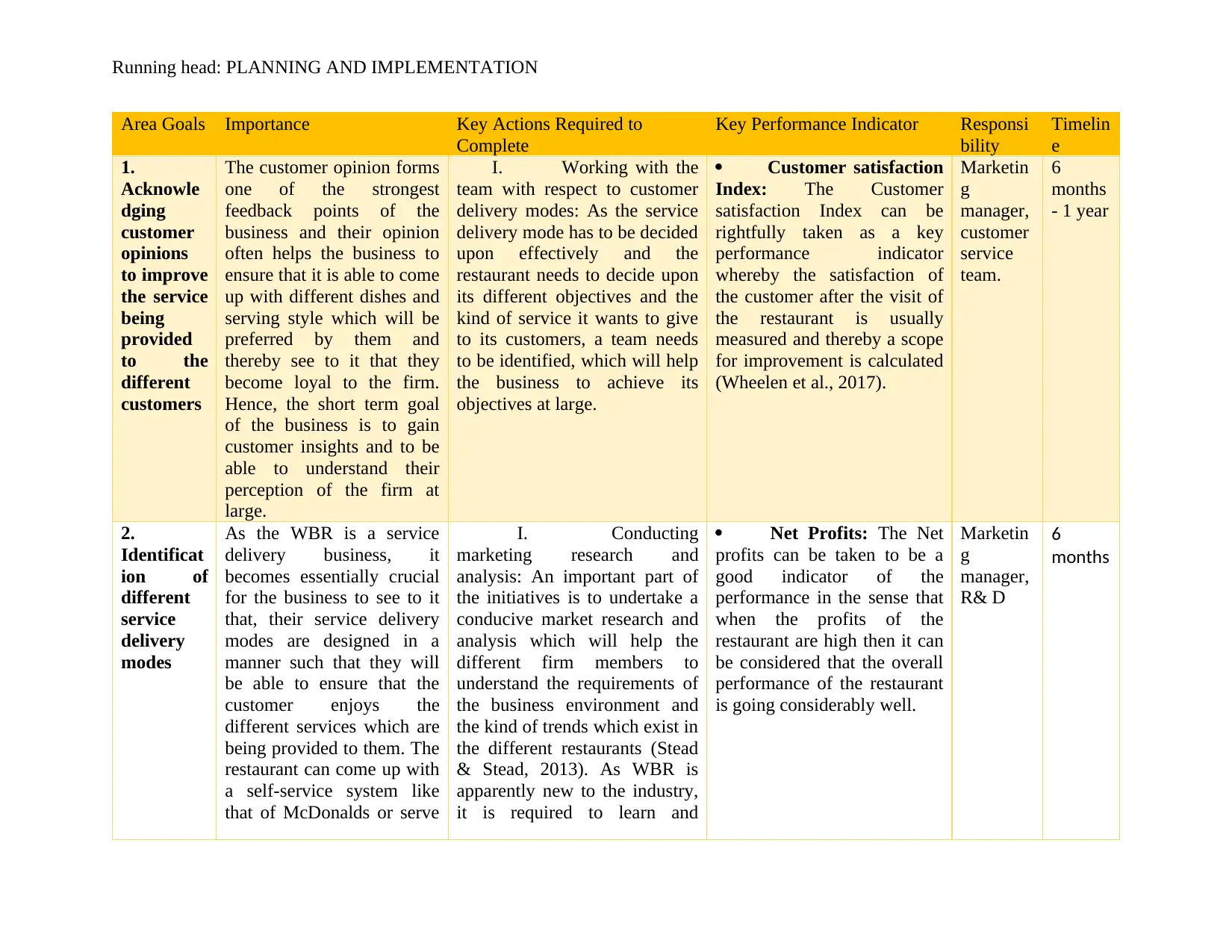
Running head: PLANNING AND IMPLEMENTATION
Area Goals Importance Key Actions Required to
Complete
Key Performance Indicator Responsi
bility
Timelin
e
1.
Acknowle
dging
customer
opinions
to improve
the service
being
provided
to the
different
customers
The customer opinion forms
one of the strongest
feedback points of the
business and their opinion
often helps the business to
ensure that it is able to come
up with different dishes and
serving style which will be
preferred by them and
thereby see to it that they
become loyal to the firm.
Hence, the short term goal
of the business is to gain
customer insights and to be
able to understand their
perception of the firm at
large.
I. Working with the
team with respect to customer
delivery modes: As the service
delivery mode has to be decided
upon effectively and the
restaurant needs to decide upon
its different objectives and the
kind of service it wants to give
to its customers, a team needs
to be identified, which will help
the business to achieve its
objectives at large.
Customer satisfaction
Index: The Customer
satisfaction Index can be
rightfully taken as a key
performance indicator
whereby the satisfaction of
the customer after the visit of
the restaurant is usually
measured and thereby a scope
for improvement is calculated
(Wheelen et al., 2017).
Marketin
g
manager,
customer
service
team.
6
months
- 1 year
2.
Identificat
ion of
different
service
delivery
modes
As the WBR is a service
delivery business, it
becomes essentially crucial
for the business to see to it
that, their service delivery
modes are designed in a
manner such that they will
be able to ensure that the
customer enjoys the
different services which are
being provided to them. The
restaurant can come up with
a self-service system like
that of McDonalds or serve
I. Conducting
marketing research and
analysis: An important part of
the initiatives is to undertake a
conducive market research and
analysis which will help the
different firm members to
understand the requirements of
the business environment and
the kind of trends which exist in
the different restaurants (Stead
& Stead, 2013). As WBR is
apparently new to the industry,
it is required to learn and
Net Profits: The Net
profits can be taken to be a
good indicator of the
performance in the sense that
when the profits of the
restaurant are high then it can
be considered that the overall
performance of the restaurant
is going considerably well.
Marketin
g
manager,
R& D
6
months
Area Goals Importance Key Actions Required to
Complete
Key Performance Indicator Responsi
bility
Timelin
e
1.
Acknowle
dging
customer
opinions
to improve
the service
being
provided
to the
different
customers
The customer opinion forms
one of the strongest
feedback points of the
business and their opinion
often helps the business to
ensure that it is able to come
up with different dishes and
serving style which will be
preferred by them and
thereby see to it that they
become loyal to the firm.
Hence, the short term goal
of the business is to gain
customer insights and to be
able to understand their
perception of the firm at
large.
I. Working with the
team with respect to customer
delivery modes: As the service
delivery mode has to be decided
upon effectively and the
restaurant needs to decide upon
its different objectives and the
kind of service it wants to give
to its customers, a team needs
to be identified, which will help
the business to achieve its
objectives at large.
Customer satisfaction
Index: The Customer
satisfaction Index can be
rightfully taken as a key
performance indicator
whereby the satisfaction of
the customer after the visit of
the restaurant is usually
measured and thereby a scope
for improvement is calculated
(Wheelen et al., 2017).
Marketin
g
manager,
customer
service
team.
6
months
- 1 year
2.
Identificat
ion of
different
service
delivery
modes
As the WBR is a service
delivery business, it
becomes essentially crucial
for the business to see to it
that, their service delivery
modes are designed in a
manner such that they will
be able to ensure that the
customer enjoys the
different services which are
being provided to them. The
restaurant can come up with
a self-service system like
that of McDonalds or serve
I. Conducting
marketing research and
analysis: An important part of
the initiatives is to undertake a
conducive market research and
analysis which will help the
different firm members to
understand the requirements of
the business environment and
the kind of trends which exist in
the different restaurants (Stead
& Stead, 2013). As WBR is
apparently new to the industry,
it is required to learn and
Net Profits: The Net
profits can be taken to be a
good indicator of the
performance in the sense that
when the profits of the
restaurant are high then it can
be considered that the overall
performance of the restaurant
is going considerably well.
Marketin
g
manager,
R& D
6
months
⊘ This is a preview!⊘
Do you want full access?
Subscribe today to unlock all pages.

Trusted by 1+ million students worldwide
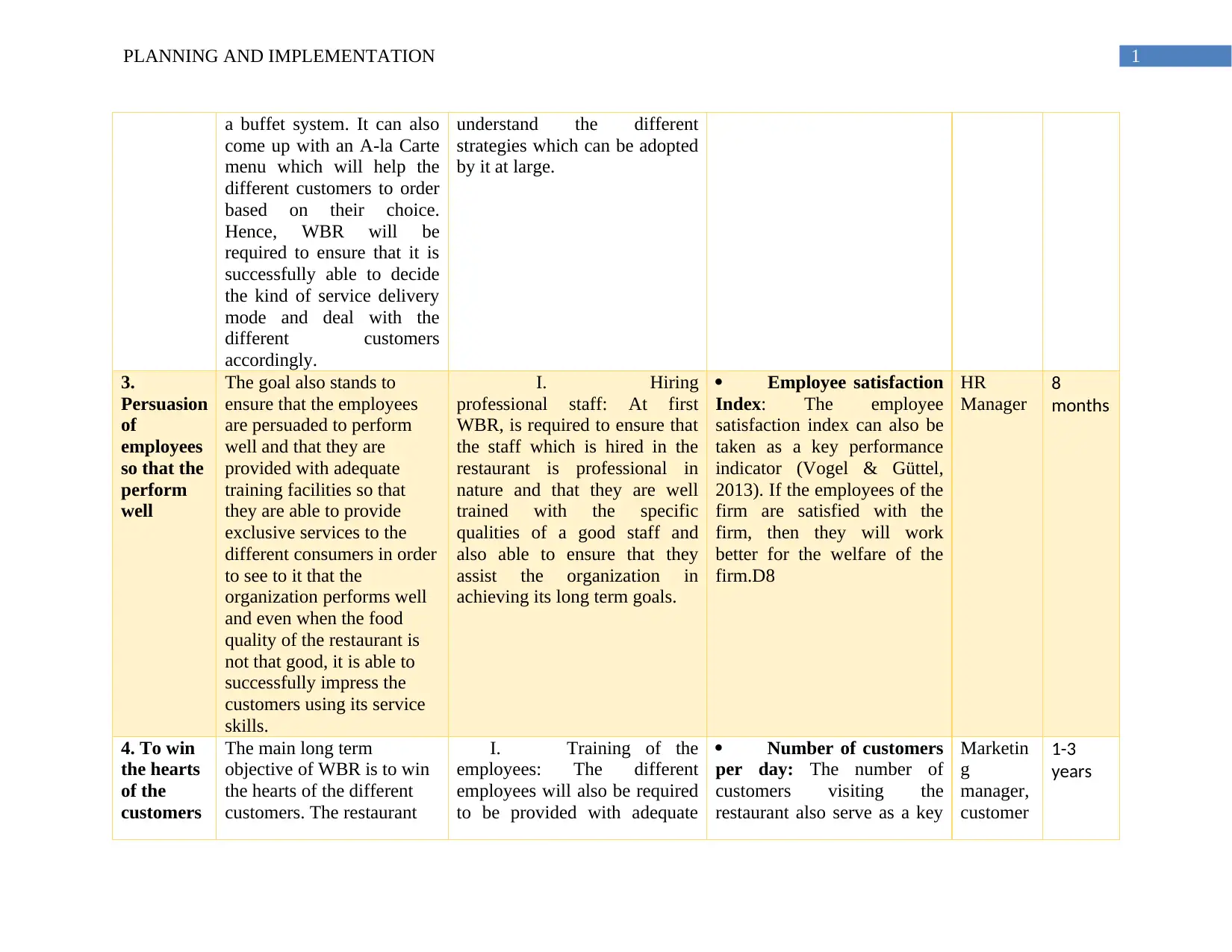
1PLANNING AND IMPLEMENTATION
a buffet system. It can also
come up with an A-la Carte
menu which will help the
different customers to order
based on their choice.
Hence, WBR will be
required to ensure that it is
successfully able to decide
the kind of service delivery
mode and deal with the
different customers
accordingly.
understand the different
strategies which can be adopted
by it at large.
3.
Persuasion
of
employees
so that the
perform
well
The goal also stands to
ensure that the employees
are persuaded to perform
well and that they are
provided with adequate
training facilities so that
they are able to provide
exclusive services to the
different consumers in order
to see to it that the
organization performs well
and even when the food
quality of the restaurant is
not that good, it is able to
successfully impress the
customers using its service
skills.
I. Hiring
professional staff: At first
WBR, is required to ensure that
the staff which is hired in the
restaurant is professional in
nature and that they are well
trained with the specific
qualities of a good staff and
also able to ensure that they
assist the organization in
achieving its long term goals.
Employee satisfaction
Index: The employee
satisfaction index can also be
taken as a key performance
indicator (Vogel & Güttel,
2013). If the employees of the
firm are satisfied with the
firm, then they will work
better for the welfare of the
firm.D8
HR
Manager
8
months
4. To win
the hearts
of the
customers
The main long term
objective of WBR is to win
the hearts of the different
customers. The restaurant
I. Training of the
employees: The different
employees will also be required
to be provided with adequate
Number of customers
per day: The number of
customers visiting the
restaurant also serve as a key
Marketin
g
manager,
customer
1-3
years
a buffet system. It can also
come up with an A-la Carte
menu which will help the
different customers to order
based on their choice.
Hence, WBR will be
required to ensure that it is
successfully able to decide
the kind of service delivery
mode and deal with the
different customers
accordingly.
understand the different
strategies which can be adopted
by it at large.
3.
Persuasion
of
employees
so that the
perform
well
The goal also stands to
ensure that the employees
are persuaded to perform
well and that they are
provided with adequate
training facilities so that
they are able to provide
exclusive services to the
different consumers in order
to see to it that the
organization performs well
and even when the food
quality of the restaurant is
not that good, it is able to
successfully impress the
customers using its service
skills.
I. Hiring
professional staff: At first
WBR, is required to ensure that
the staff which is hired in the
restaurant is professional in
nature and that they are well
trained with the specific
qualities of a good staff and
also able to ensure that they
assist the organization in
achieving its long term goals.
Employee satisfaction
Index: The employee
satisfaction index can also be
taken as a key performance
indicator (Vogel & Güttel,
2013). If the employees of the
firm are satisfied with the
firm, then they will work
better for the welfare of the
firm.D8
HR
Manager
8
months
4. To win
the hearts
of the
customers
The main long term
objective of WBR is to win
the hearts of the different
customers. The restaurant
I. Training of the
employees: The different
employees will also be required
to be provided with adequate
Number of customers
per day: The number of
customers visiting the
restaurant also serve as a key
Marketin
g
manager,
customer
1-3
years
Paraphrase This Document
Need a fresh take? Get an instant paraphrase of this document with our AI Paraphraser
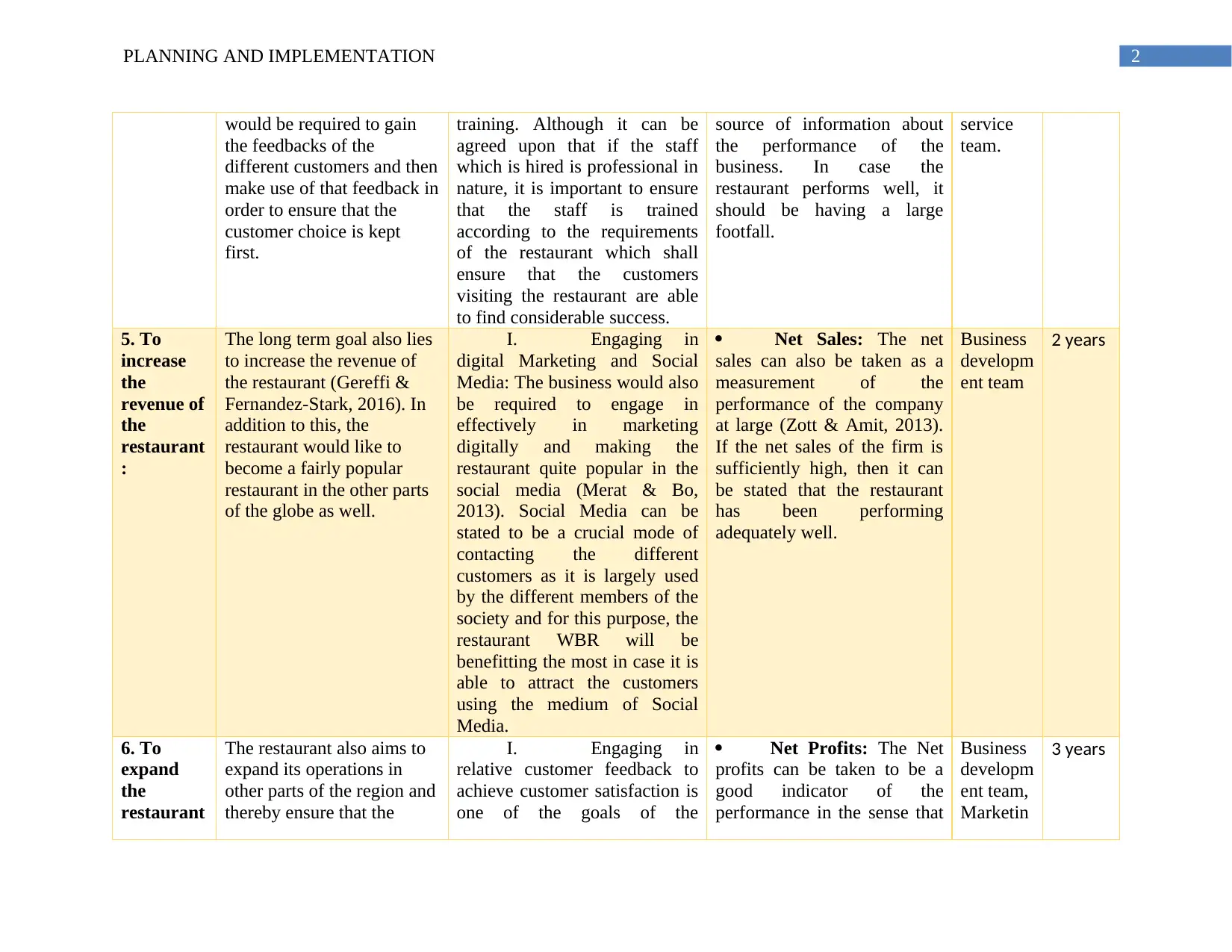
2PLANNING AND IMPLEMENTATION
would be required to gain
the feedbacks of the
different customers and then
make use of that feedback in
order to ensure that the
customer choice is kept
first.
training. Although it can be
agreed upon that if the staff
which is hired is professional in
nature, it is important to ensure
that the staff is trained
according to the requirements
of the restaurant which shall
ensure that the customers
visiting the restaurant are able
to find considerable success.
source of information about
the performance of the
business. In case the
restaurant performs well, it
should be having a large
footfall.
service
team.
5. To
increase
the
revenue of
the
restaurant
:
The long term goal also lies
to increase the revenue of
the restaurant (Gereffi &
Fernandez-Stark, 2016). In
addition to this, the
restaurant would like to
become a fairly popular
restaurant in the other parts
of the globe as well.
I. Engaging in
digital Marketing and Social
Media: The business would also
be required to engage in
effectively in marketing
digitally and making the
restaurant quite popular in the
social media (Merat & Bo,
2013). Social Media can be
stated to be a crucial mode of
contacting the different
customers as it is largely used
by the different members of the
society and for this purpose, the
restaurant WBR will be
benefitting the most in case it is
able to attract the customers
using the medium of Social
Media.
Net Sales: The net
sales can also be taken as a
measurement of the
performance of the company
at large (Zott & Amit, 2013).
If the net sales of the firm is
sufficiently high, then it can
be stated that the restaurant
has been performing
adequately well.
Business
developm
ent team
2 years
6. To
expand
the
restaurant
The restaurant also aims to
expand its operations in
other parts of the region and
thereby ensure that the
I. Engaging in
relative customer feedback to
achieve customer satisfaction is
one of the goals of the
Net Profits: The Net
profits can be taken to be a
good indicator of the
performance in the sense that
Business
developm
ent team,
Marketin
3 years
would be required to gain
the feedbacks of the
different customers and then
make use of that feedback in
order to ensure that the
customer choice is kept
first.
training. Although it can be
agreed upon that if the staff
which is hired is professional in
nature, it is important to ensure
that the staff is trained
according to the requirements
of the restaurant which shall
ensure that the customers
visiting the restaurant are able
to find considerable success.
source of information about
the performance of the
business. In case the
restaurant performs well, it
should be having a large
footfall.
service
team.
5. To
increase
the
revenue of
the
restaurant
:
The long term goal also lies
to increase the revenue of
the restaurant (Gereffi &
Fernandez-Stark, 2016). In
addition to this, the
restaurant would like to
become a fairly popular
restaurant in the other parts
of the globe as well.
I. Engaging in
digital Marketing and Social
Media: The business would also
be required to engage in
effectively in marketing
digitally and making the
restaurant quite popular in the
social media (Merat & Bo,
2013). Social Media can be
stated to be a crucial mode of
contacting the different
customers as it is largely used
by the different members of the
society and for this purpose, the
restaurant WBR will be
benefitting the most in case it is
able to attract the customers
using the medium of Social
Media.
Net Sales: The net
sales can also be taken as a
measurement of the
performance of the company
at large (Zott & Amit, 2013).
If the net sales of the firm is
sufficiently high, then it can
be stated that the restaurant
has been performing
adequately well.
Business
developm
ent team
2 years
6. To
expand
the
restaurant
The restaurant also aims to
expand its operations in
other parts of the region and
thereby ensure that the
I. Engaging in
relative customer feedback to
achieve customer satisfaction is
one of the goals of the
Net Profits: The Net
profits can be taken to be a
good indicator of the
performance in the sense that
Business
developm
ent team,
Marketin
3 years
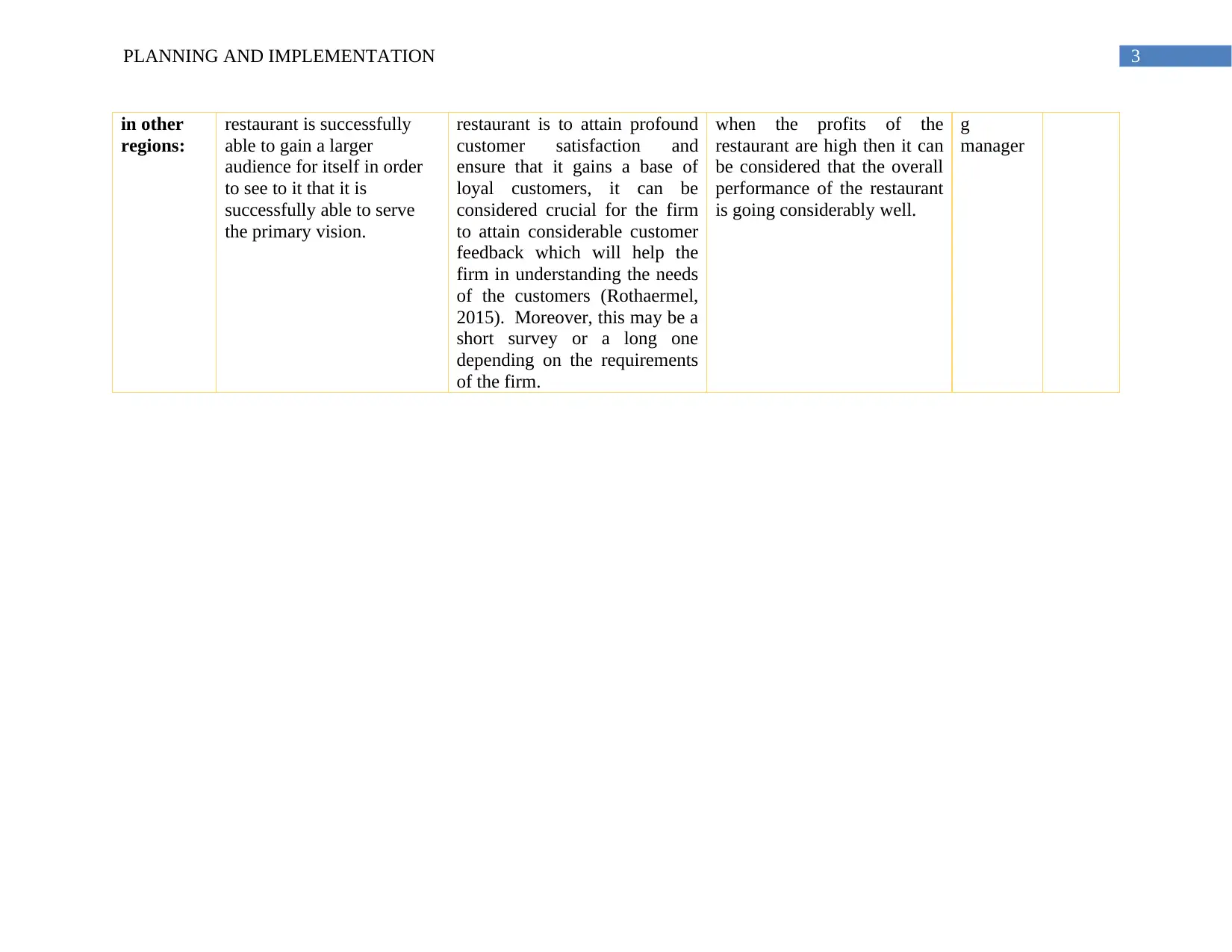
3PLANNING AND IMPLEMENTATION
in other
regions:
restaurant is successfully
able to gain a larger
audience for itself in order
to see to it that it is
successfully able to serve
the primary vision.
restaurant is to attain profound
customer satisfaction and
ensure that it gains a base of
loyal customers, it can be
considered crucial for the firm
to attain considerable customer
feedback which will help the
firm in understanding the needs
of the customers (Rothaermel,
2015). Moreover, this may be a
short survey or a long one
depending on the requirements
of the firm.
when the profits of the
restaurant are high then it can
be considered that the overall
performance of the restaurant
is going considerably well.
g
manager
in other
regions:
restaurant is successfully
able to gain a larger
audience for itself in order
to see to it that it is
successfully able to serve
the primary vision.
restaurant is to attain profound
customer satisfaction and
ensure that it gains a base of
loyal customers, it can be
considered crucial for the firm
to attain considerable customer
feedback which will help the
firm in understanding the needs
of the customers (Rothaermel,
2015). Moreover, this may be a
short survey or a long one
depending on the requirements
of the firm.
when the profits of the
restaurant are high then it can
be considered that the overall
performance of the restaurant
is going considerably well.
g
manager
⊘ This is a preview!⊘
Do you want full access?
Subscribe today to unlock all pages.

Trusted by 1+ million students worldwide
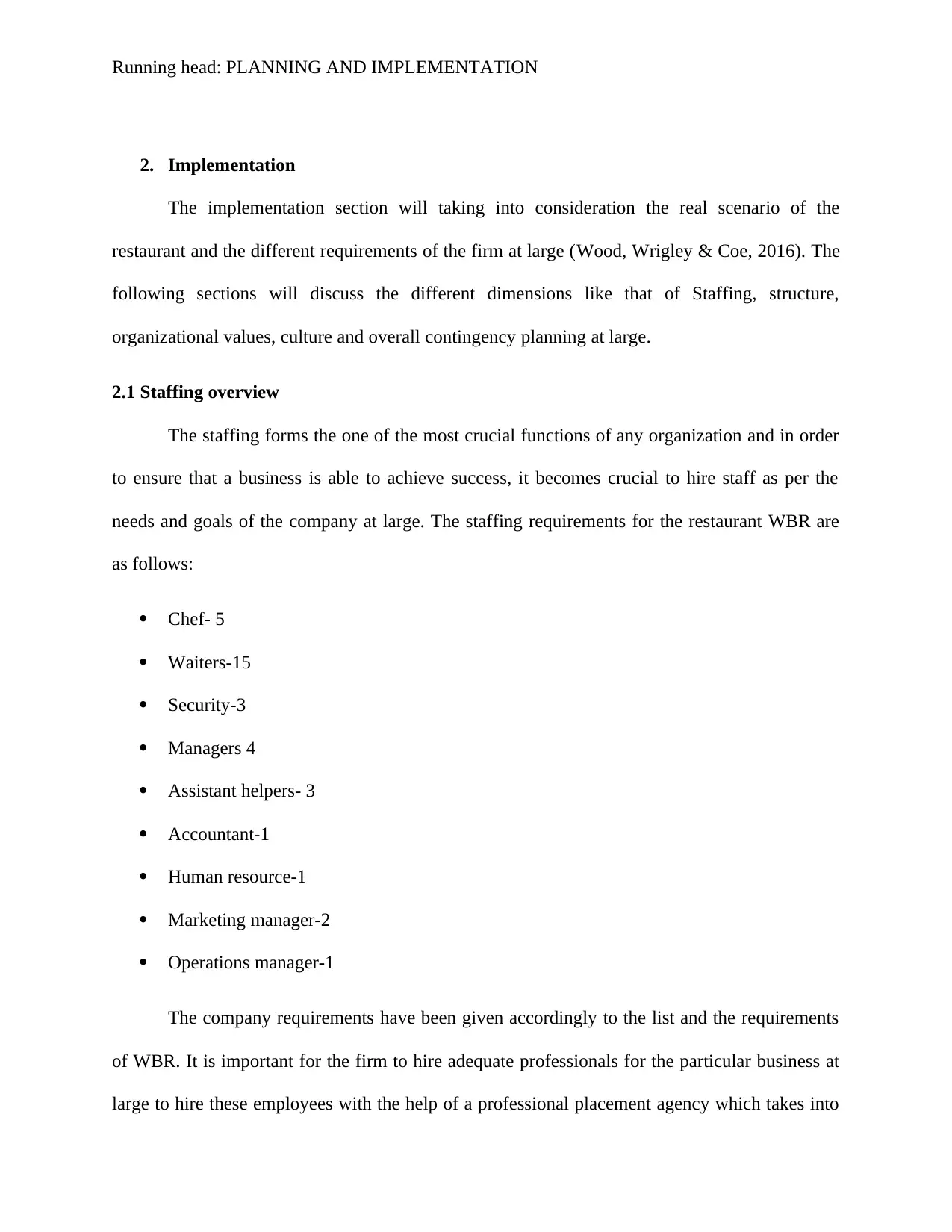
Running head: PLANNING AND IMPLEMENTATION
2. Implementation
The implementation section will taking into consideration the real scenario of the
restaurant and the different requirements of the firm at large (Wood, Wrigley & Coe, 2016). The
following sections will discuss the different dimensions like that of Staffing, structure,
organizational values, culture and overall contingency planning at large.
2.1 Staffing overview
The staffing forms the one of the most crucial functions of any organization and in order
to ensure that a business is able to achieve success, it becomes crucial to hire staff as per the
needs and goals of the company at large. The staffing requirements for the restaurant WBR are
as follows:
Chef- 5
Waiters-15
Security-3
Managers 4
Assistant helpers- 3
Accountant-1
Human resource-1
Marketing manager-2
Operations manager-1
The company requirements have been given accordingly to the list and the requirements
of WBR. It is important for the firm to hire adequate professionals for the particular business at
large to hire these employees with the help of a professional placement agency which takes into
2. Implementation
The implementation section will taking into consideration the real scenario of the
restaurant and the different requirements of the firm at large (Wood, Wrigley & Coe, 2016). The
following sections will discuss the different dimensions like that of Staffing, structure,
organizational values, culture and overall contingency planning at large.
2.1 Staffing overview
The staffing forms the one of the most crucial functions of any organization and in order
to ensure that a business is able to achieve success, it becomes crucial to hire staff as per the
needs and goals of the company at large. The staffing requirements for the restaurant WBR are
as follows:
Chef- 5
Waiters-15
Security-3
Managers 4
Assistant helpers- 3
Accountant-1
Human resource-1
Marketing manager-2
Operations manager-1
The company requirements have been given accordingly to the list and the requirements
of WBR. It is important for the firm to hire adequate professionals for the particular business at
large to hire these employees with the help of a professional placement agency which takes into
Paraphrase This Document
Need a fresh take? Get an instant paraphrase of this document with our AI Paraphraser
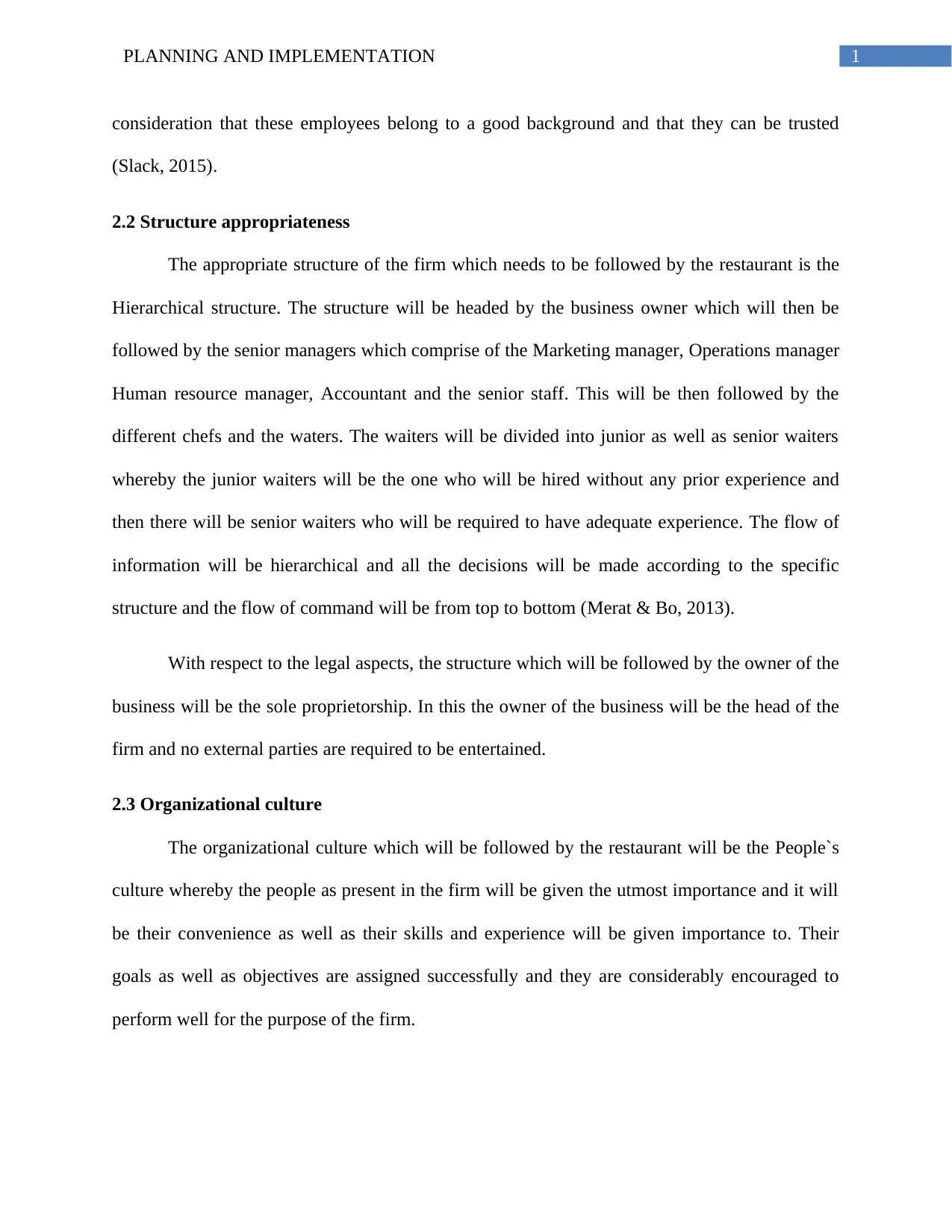
1PLANNING AND IMPLEMENTATION
consideration that these employees belong to a good background and that they can be trusted
(Slack, 2015).
2.2 Structure appropriateness
The appropriate structure of the firm which needs to be followed by the restaurant is the
Hierarchical structure. The structure will be headed by the business owner which will then be
followed by the senior managers which comprise of the Marketing manager, Operations manager
Human resource manager, Accountant and the senior staff. This will be then followed by the
different chefs and the waters. The waiters will be divided into junior as well as senior waiters
whereby the junior waiters will be the one who will be hired without any prior experience and
then there will be senior waiters who will be required to have adequate experience. The flow of
information will be hierarchical and all the decisions will be made according to the specific
structure and the flow of command will be from top to bottom (Merat & Bo, 2013).
With respect to the legal aspects, the structure which will be followed by the owner of the
business will be the sole proprietorship. In this the owner of the business will be the head of the
firm and no external parties are required to be entertained.
2.3 Organizational culture
The organizational culture which will be followed by the restaurant will be the People`s
culture whereby the people as present in the firm will be given the utmost importance and it will
be their convenience as well as their skills and experience will be given importance to. Their
goals as well as objectives are assigned successfully and they are considerably encouraged to
perform well for the purpose of the firm.
consideration that these employees belong to a good background and that they can be trusted
(Slack, 2015).
2.2 Structure appropriateness
The appropriate structure of the firm which needs to be followed by the restaurant is the
Hierarchical structure. The structure will be headed by the business owner which will then be
followed by the senior managers which comprise of the Marketing manager, Operations manager
Human resource manager, Accountant and the senior staff. This will be then followed by the
different chefs and the waters. The waiters will be divided into junior as well as senior waiters
whereby the junior waiters will be the one who will be hired without any prior experience and
then there will be senior waiters who will be required to have adequate experience. The flow of
information will be hierarchical and all the decisions will be made according to the specific
structure and the flow of command will be from top to bottom (Merat & Bo, 2013).
With respect to the legal aspects, the structure which will be followed by the owner of the
business will be the sole proprietorship. In this the owner of the business will be the head of the
firm and no external parties are required to be entertained.
2.3 Organizational culture
The organizational culture which will be followed by the restaurant will be the People`s
culture whereby the people as present in the firm will be given the utmost importance and it will
be their convenience as well as their skills and experience will be given importance to. Their
goals as well as objectives are assigned successfully and they are considerably encouraged to
perform well for the purpose of the firm.
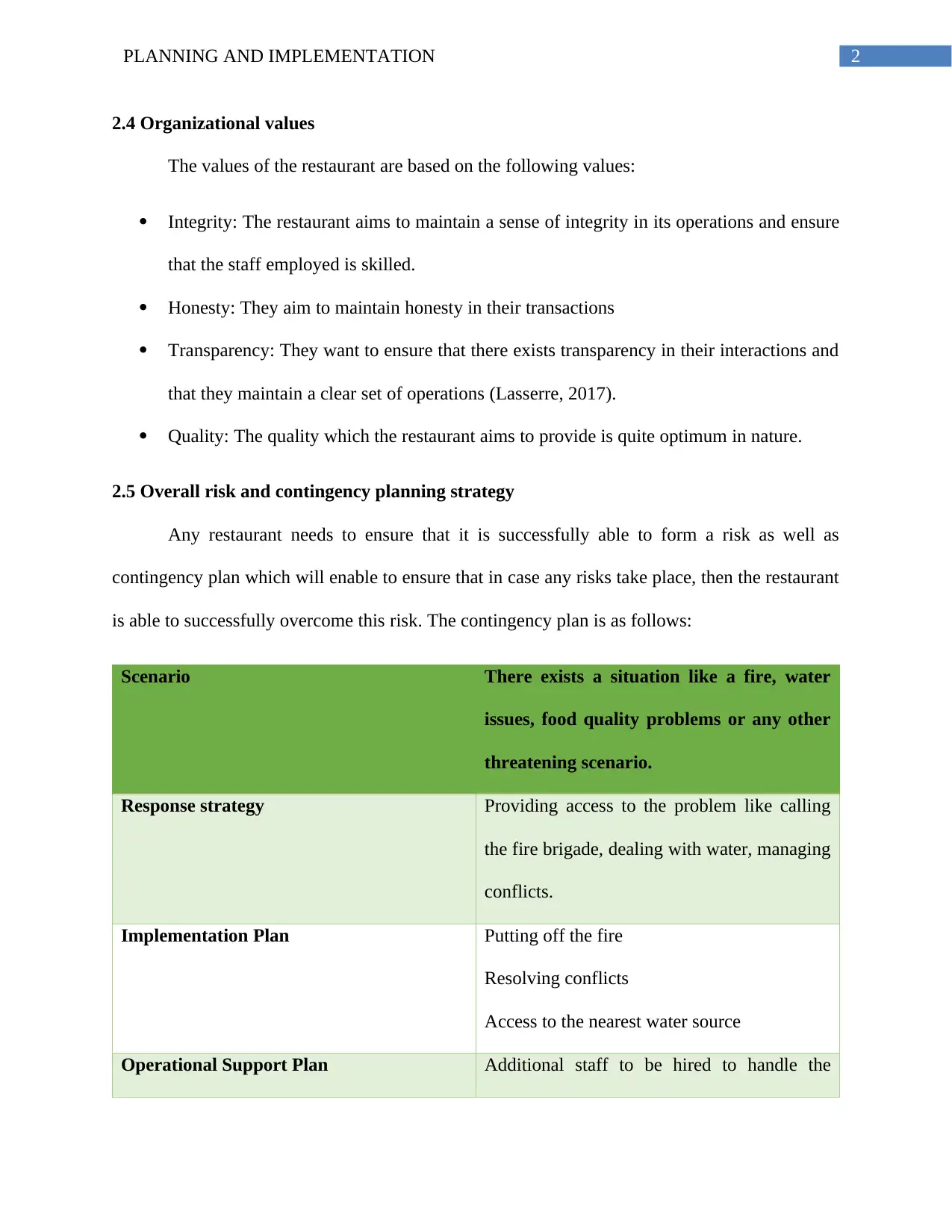
2PLANNING AND IMPLEMENTATION
2.4 Organizational values
The values of the restaurant are based on the following values:
Integrity: The restaurant aims to maintain a sense of integrity in its operations and ensure
that the staff employed is skilled.
Honesty: They aim to maintain honesty in their transactions
Transparency: They want to ensure that there exists transparency in their interactions and
that they maintain a clear set of operations (Lasserre, 2017).
Quality: The quality which the restaurant aims to provide is quite optimum in nature.
2.5 Overall risk and contingency planning strategy
Any restaurant needs to ensure that it is successfully able to form a risk as well as
contingency plan which will enable to ensure that in case any risks take place, then the restaurant
is able to successfully overcome this risk. The contingency plan is as follows:
Scenario There exists a situation like a fire, water
issues, food quality problems or any other
threatening scenario.
Response strategy Providing access to the problem like calling
the fire brigade, dealing with water, managing
conflicts.
Implementation Plan Putting off the fire
Resolving conflicts
Access to the nearest water source
Operational Support Plan Additional staff to be hired to handle the
2.4 Organizational values
The values of the restaurant are based on the following values:
Integrity: The restaurant aims to maintain a sense of integrity in its operations and ensure
that the staff employed is skilled.
Honesty: They aim to maintain honesty in their transactions
Transparency: They want to ensure that there exists transparency in their interactions and
that they maintain a clear set of operations (Lasserre, 2017).
Quality: The quality which the restaurant aims to provide is quite optimum in nature.
2.5 Overall risk and contingency planning strategy
Any restaurant needs to ensure that it is successfully able to form a risk as well as
contingency plan which will enable to ensure that in case any risks take place, then the restaurant
is able to successfully overcome this risk. The contingency plan is as follows:
Scenario There exists a situation like a fire, water
issues, food quality problems or any other
threatening scenario.
Response strategy Providing access to the problem like calling
the fire brigade, dealing with water, managing
conflicts.
Implementation Plan Putting off the fire
Resolving conflicts
Access to the nearest water source
Operational Support Plan Additional staff to be hired to handle the
⊘ This is a preview!⊘
Do you want full access?
Subscribe today to unlock all pages.

Trusted by 1+ million students worldwide
1 out of 17
Related Documents
Your All-in-One AI-Powered Toolkit for Academic Success.
+13062052269
info@desklib.com
Available 24*7 on WhatsApp / Email
![[object Object]](/_next/static/media/star-bottom.7253800d.svg)
Unlock your academic potential
Copyright © 2020–2025 A2Z Services. All Rights Reserved. Developed and managed by ZUCOL.





